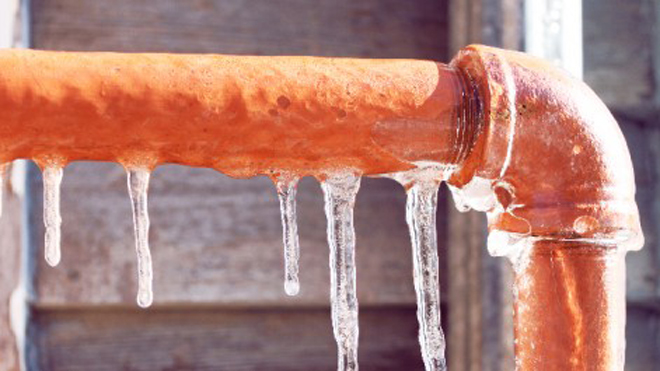Avoiding Frozen Plumbing in Winter: Pro Tips
Avoiding Frozen Plumbing in Winter: Pro Tips
Blog Article
We've encountered this post relating to Helpful Tips to Prevent Frozen Pipes this Winter down the page on the web and figured it made good sense to discuss it with you here.

Winter can ruin your plumbing, specifically by freezing pipes. Right here's how to avoid it from occurring and what to do if it does.
Introduction
As temperature levels decrease, the threat of frozen pipes rises, possibly causing costly repair work and water damage. Understanding just how to prevent frozen pipes is essential for homeowners in cold environments.
Avoidance Tips
Insulating at risk pipelines
Cover pipelines in insulation sleeves or use warm tape to safeguard them from freezing temperature levels. Concentrate on pipes in unheated or exterior locations of the home.
Home heating techniques
Maintain indoor areas adequately heated, particularly areas with pipes. Open cupboard doors to allow cozy air to flow around pipes under sinks.
Exactly how to recognize frozen pipelines
Seek lowered water circulation from taps, unusual odors or sounds from pipelines, and noticeable frost on exposed pipelines.
Long-Term Solutions
Structural adjustments
Think about rerouting pipelines away from exterior wall surfaces or unheated locations. Include added insulation to attic rooms, cellars, and crawl spaces.
Upgrading insulation
Purchase top notch insulation for pipes, attics, and wall surfaces. Proper insulation helps preserve constant temperatures and reduces the threat of frozen pipes.
Protecting Outside Pipes
Yard hose pipes and exterior taps
Disconnect and drain garden hoses before winter. Set up frost-proof spigots or cover outdoor faucets with insulated caps.
Comprehending Icy Pipelines
What creates pipelines to ice up?
Pipelines freeze when subjected to temperature levels listed below 32 ° F (0 ° C) for expanded periods. As water inside the pipes freezes, it increases, putting pressure on the pipe walls and possibly causing them to break.
Dangers and damages
Icy pipelines can lead to supply of water interruptions, home damages, and costly repair services. Ruptured pipelines can flooding homes and create considerable structural damage.
Signs of Frozen Piping
Identifying icy pipelines early can avoid them from rupturing.
What to Do If Your Pipes Freeze
Immediate activities to take
If you suspect icy pipes, keep faucets available to ease stress as the ice melts. Utilize a hairdryer or towels taken in warm water to thaw pipes slowly.
Conclusion
Preventing icy pipes needs proactive measures and fast feedbacks. By comprehending the causes, signs, and safety nets, homeowners can secure their pipes throughout cold weather.
6 Proven Ways to Prevent Frozen Pipes and Protect Your Home
Disconnect and Drain Garden Hoses
Before winter arrives, start by disconnecting your garden hoses and draining any remaining water. Close the shut-off valves that supply outdoor hose bibs and leave the outdoor faucet open to allow any residual water to drain. For extra protection, consider using faucet covers throughout the colder months. It’s also important to drain water from any sprinkler supply lines following the manufacturer’s directions.
Insulate Exposed Pipes
Insulating your pipes is an effective way to prevent freezing. Pipe insulation is readily available at home improvement stores and is relatively inexpensive. Pay close attention to pipes in unheated areas such as the attic, basement, crawl spaces, or garage. Apply foam insulation generously to create a buffer against the cold. You can also wrap your pipes in heat tape or thermostat-controlled heat cables for added warmth.
Seal Air Leaks
Inspect your home for any cracks or openings that could let in cold air. Seal any holes around the piping in interior or exterior walls, as well as the sill plates where your home rests on its foundation. Additionally, make sure to keep your garage door closed unless you’re entering or exiting. Leaving it open creates a significant air leak that can lead to frozen pipes.
Allow Warm Air Circulation
During cold snaps, it’s essential to allow warm air to circulate evenly throughout your home. Leave interior doors ajar to promote better airflow. Open kitchen and bathroom cabinets to help distribute heat consistently around the rooms. If you have small children or pets, be sure to remove any household chemicals or potentially harmful cleaners from open cabinets for safety.
Let Faucets Drip
A small trickle of water can make a big difference in preventing ice formation inside your pipes. When temperatures drop significantly, start a drip of water from all faucets served by exposed pipes. This continuous flow helps prevent the water from freezing. Additionally, running a few faucets slightly can relieve pressure inside the pipes, reducing the chances of a rupture if the water inside does freeze.
https://choateshvac.com/6-proven-ways-to-prevent-frozen-pipes-and-protect-your-home/

I hope you enjoyed our article about How to Prevent Your Pipes From Freezing. Thanks a ton for spending some time to browse our short article. So long as you liked our blog entry plz consider to pass it around. Thank you for going through it.
Source Report this page